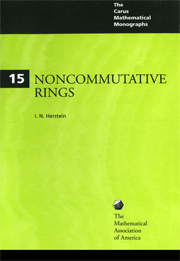1 - THE JACOBSON RADICAL
Summary
This chapter has as its major goal the creation of the first steps needed to construct a general structure theory for associative rings. The aim of any structure theory is the description of some general objects in terms of some simpler ones—simpler in some perceptible sense, perhaps in terms of concreteness, perhaps in terms of tractability. Of essential importance, after one has decided upon these simpler objects, is to find a method of passing down to them and to discover how they weave together to yield the general system with which we began.
In carrying out such a program there are many paths one can follow, many classes of candidates for these simpler objects, and one must choose among these for that theory which is most fruitful in producing decisive results. In the case of rings there seems to be no doubt that the fundamental structure theory laid out by Jacobson is the appropriate one. The best proof of this remark is the host of striking theorems which have resulted from the use of these methods.
Modules. Essential to everything that we shall discuss—in fact essential in every phase of algebra—is the notion of a module over a ring R or, in short, an R-module. To be absolutely precise we should say a right R-module for we shall allow the elements of R to act on the module from the right. However we shall merely say R-module, understanding by that term a right R-module.
Information
- Type
- Chapter
- Information
- Noncommutative Rings , pp. 1 - 38Publisher: Mathematical Association of AmericaPrint publication year: 1968
